Management Accounting: Cost Analysis and Inventory Valuation
Added on 2023-04-04
23 Pages4654 Words63 Views
Management
accounting
accounting

Table of Contents
INTRODUCTION...........................................................................................................................................4
Question 1...............................................................................................................................................4
a. Distinguishing various costs incurred by Smart looks..........................................................................4
b. Presenting different types of cost related to clothing retail firm.........................................................4
Q.2...........................................................................................................................................................6
(A) Calculation of total cost (TC) and unit cost (UC).................................................................................6
(B) Cost data analysis...............................................................................................................................7
Q.3 Inventory valuation...........................................................................................................................8
(1) First-in, first-out.................................................................................................................................8
(2) Last-in, First-out.................................................................................................................................8
(3) Average costs.....................................................................................................................................9
Q.4. Calculation of cost of goods sold under FIFO, LIFO and average cost method...............................10
Question 5.............................................................................................................................................10
A. Identifying critical success factors and performance indicators........................................................10
B............................................................................................................................................................11
1. Identifying the ways through which cost level can be reduced.........................................................11
2. Assessing the manner in which quality can be enhanced..................................................................12
TASK 2........................................................................................................................................................12
Q.6.........................................................................................................................................................12
(A). Meaning of budget..........................................................................................................................12
(B). Purpose or objectives of budgetary planning..................................................................................12
(C) Different methods of budget prearation for Smart Looks................................................................13
Question7..............................................................................................................................................14
a. Sales budget.......................................................................................................................................14
b. Production budget.............................................................................................................................15
c. Raw material budgets........................................................................................................................15
d. Labor budgets....................................................................................................................................15
e. Total overhead budget......................................................................................................................16
Q.8. Preparing cash budget and its analysis..........................................................................................16
INTRODUCTION...........................................................................................................................................4
Question 1...............................................................................................................................................4
a. Distinguishing various costs incurred by Smart looks..........................................................................4
b. Presenting different types of cost related to clothing retail firm.........................................................4
Q.2...........................................................................................................................................................6
(A) Calculation of total cost (TC) and unit cost (UC).................................................................................6
(B) Cost data analysis...............................................................................................................................7
Q.3 Inventory valuation...........................................................................................................................8
(1) First-in, first-out.................................................................................................................................8
(2) Last-in, First-out.................................................................................................................................8
(3) Average costs.....................................................................................................................................9
Q.4. Calculation of cost of goods sold under FIFO, LIFO and average cost method...............................10
Question 5.............................................................................................................................................10
A. Identifying critical success factors and performance indicators........................................................10
B............................................................................................................................................................11
1. Identifying the ways through which cost level can be reduced.........................................................11
2. Assessing the manner in which quality can be enhanced..................................................................12
TASK 2........................................................................................................................................................12
Q.6.........................................................................................................................................................12
(A). Meaning of budget..........................................................................................................................12
(B). Purpose or objectives of budgetary planning..................................................................................12
(C) Different methods of budget prearation for Smart Looks................................................................13
Question7..............................................................................................................................................14
a. Sales budget.......................................................................................................................................14
b. Production budget.............................................................................................................................15
c. Raw material budgets........................................................................................................................15
d. Labor budgets....................................................................................................................................15
e. Total overhead budget......................................................................................................................16
Q.8. Preparing cash budget and its analysis..........................................................................................16
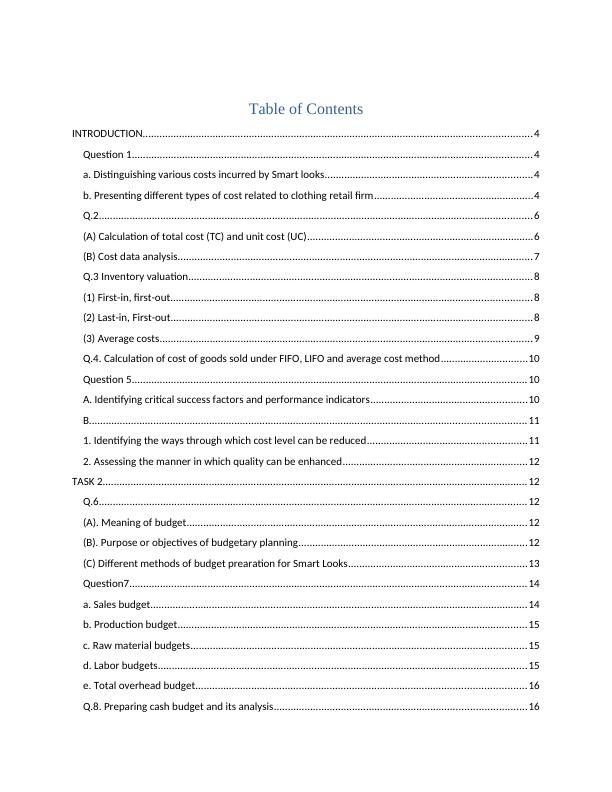
TASK 3........................................................................................................................................................18
Question 9.............................................................................................................................................18
a. Computation of planned margin for March 2017..............................................................................18
b. Calculation of actual profit................................................................................................................18
c. Computation of material and labor variances....................................................................................19
d. Preparing reconciliation profit...........................................................................................................20
Question 10...........................................................................................................................................20
Finding causes of deviations and taking correction actions for improvement.......................................20
CONCLUSION.............................................................................................................................................21
REFERENCES..............................................................................................................................................22
Question 9.............................................................................................................................................18
a. Computation of planned margin for March 2017..............................................................................18
b. Calculation of actual profit................................................................................................................18
c. Computation of material and labor variances....................................................................................19
d. Preparing reconciliation profit...........................................................................................................20
Question 10...........................................................................................................................................20
Finding causes of deviations and taking correction actions for improvement.......................................20
CONCLUSION.............................................................................................................................................21
REFERENCES..............................................................................................................................................22
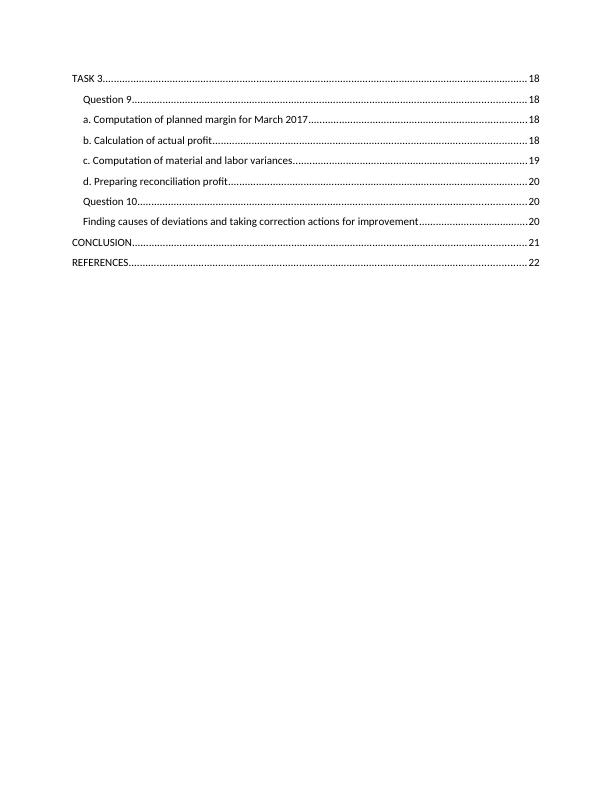
INTRODUCTION
Management accounting includes several tools and techniques which in turn help in
preparing suitable reports for decision making. In the present times, each business unit lays
emphasis on employing varied tools for getting information about the extent to which each
business unit is performing in a well manner. Moreover, managerial reporting provides deeper
insight to the firm about the area which requires improvement. Thus, management accounting
system aids in the growth and profitability aspect of firm to a great extent. The present report is
based on Smart Looks which is the clothing retailer of UK. It provides customers with high
quality fashion apparel at affordable prices. In this, report will furnish information regarding the
different types of cost associated with the manufacturing of clothes. Further, it will also provide
understanding about the manner in which suitable plan can be developed in monetary terms.
Besides this, report will help in understanding the manner in which variance analysis technique
helps in taking strategic action for the purpose of improvement.
Question 1
a. Distinguishing various costs incurred by Smart looks
Cited case situation presents that Smart Looks has incurred following expenses which fall
in the category of either fixed, semi-variable or variable. Hence, category of cost incurred is
enumerated below:
Material for clothes: Variable cost
Factory rent: Fixed cost
Power of sewing machines: Semi-variable cost
Telephone expenses: semi-variable cost
Office rates: Fixed cost
Delivery drivers: Semi-variable cost
Factory heating: Variable cost
b. Presenting different types of cost related to clothing retail firm
Cost may be defined as a sum of all the expenses which are incurred by firm to
manufacture clothes. In the business organization, firm has to incur several costs which in turn
Management accounting includes several tools and techniques which in turn help in
preparing suitable reports for decision making. In the present times, each business unit lays
emphasis on employing varied tools for getting information about the extent to which each
business unit is performing in a well manner. Moreover, managerial reporting provides deeper
insight to the firm about the area which requires improvement. Thus, management accounting
system aids in the growth and profitability aspect of firm to a great extent. The present report is
based on Smart Looks which is the clothing retailer of UK. It provides customers with high
quality fashion apparel at affordable prices. In this, report will furnish information regarding the
different types of cost associated with the manufacturing of clothes. Further, it will also provide
understanding about the manner in which suitable plan can be developed in monetary terms.
Besides this, report will help in understanding the manner in which variance analysis technique
helps in taking strategic action for the purpose of improvement.
Question 1
a. Distinguishing various costs incurred by Smart looks
Cited case situation presents that Smart Looks has incurred following expenses which fall
in the category of either fixed, semi-variable or variable. Hence, category of cost incurred is
enumerated below:
Material for clothes: Variable cost
Factory rent: Fixed cost
Power of sewing machines: Semi-variable cost
Telephone expenses: semi-variable cost
Office rates: Fixed cost
Delivery drivers: Semi-variable cost
Factory heating: Variable cost
b. Presenting different types of cost related to clothing retail firm
Cost may be defined as a sum of all the expenses which are incurred by firm to
manufacture clothes. In the business organization, firm has to incur several costs which in turn
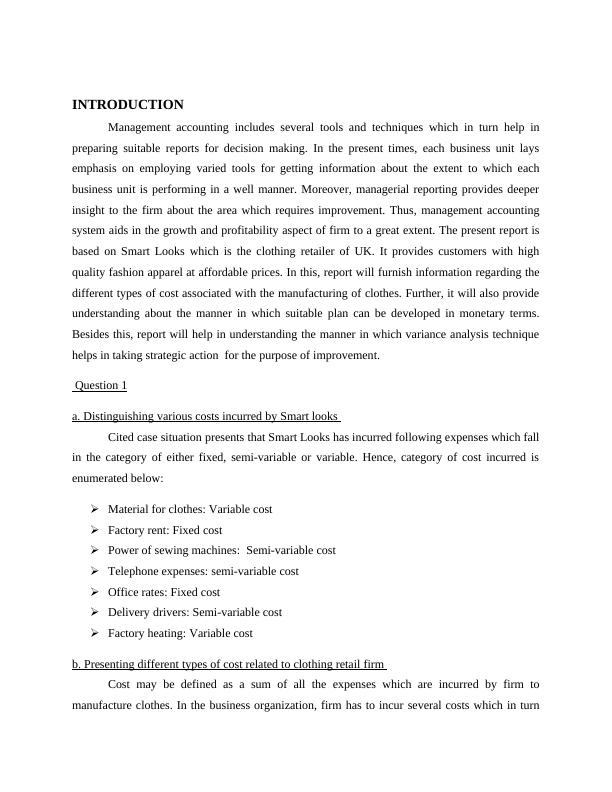
place direct impact on the cost and profit level. From manufacturing to offering products or
services business entity has to incur several expenses which can be categorized in the following
manner:
Degree of Traceability
Direct expenses: It refers to those which are highly associated with the manufacturing of
product such as clothes. Hence, material, labor cost is the main examples of direct
expenditure.
Indirect expenses: Such category of expenses include selling and distribution,
administration expenses which business unit has to incur for offering high quality
products or services to the customers (Cost Classification, 2017). Hence, indirect
expenses are those which business unit to incur for ensuring the smooth functioning of
business operations.
Changes take place in activity or volume
Fixed cost: Factory rent, insurance, rent etc. comes under the category of fixed cost.
Thus, fixed costs are the one which remains unchanged irrespective the level of output
produced. Hence, per unit cost decreases when production level inclines and vice versa.
Variable cost: Such cost is directly associated with the number of unit produced. Variable
cost increases in line with the production level (Mohanty, 2014). Material, heating
expenses etc. are the main examples of variable cost.
Semi-variable cost: It may be served as those whose specific portion remains fixed to a
specific unit and balance portion considered as variable. Electricity, promotional are the
main examples of semi-variable cost which Smart Looks needs to incur.
Based on product
Direct material: In clothing business, retailer requires raw fabric to make finished
products. Hence, by multiplying the number of units manufacture with rate of per meter
direct material cost can be assessed.
Direct labor: This cost may be defined as wages which are paid by clothing retailer to the
labor on the basis of hours spend by them while manufacturing the apparels.
services business entity has to incur several expenses which can be categorized in the following
manner:
Degree of Traceability
Direct expenses: It refers to those which are highly associated with the manufacturing of
product such as clothes. Hence, material, labor cost is the main examples of direct
expenditure.
Indirect expenses: Such category of expenses include selling and distribution,
administration expenses which business unit has to incur for offering high quality
products or services to the customers (Cost Classification, 2017). Hence, indirect
expenses are those which business unit to incur for ensuring the smooth functioning of
business operations.
Changes take place in activity or volume
Fixed cost: Factory rent, insurance, rent etc. comes under the category of fixed cost.
Thus, fixed costs are the one which remains unchanged irrespective the level of output
produced. Hence, per unit cost decreases when production level inclines and vice versa.
Variable cost: Such cost is directly associated with the number of unit produced. Variable
cost increases in line with the production level (Mohanty, 2014). Material, heating
expenses etc. are the main examples of variable cost.
Semi-variable cost: It may be served as those whose specific portion remains fixed to a
specific unit and balance portion considered as variable. Electricity, promotional are the
main examples of semi-variable cost which Smart Looks needs to incur.
Based on product
Direct material: In clothing business, retailer requires raw fabric to make finished
products. Hence, by multiplying the number of units manufacture with rate of per meter
direct material cost can be assessed.
Direct labor: This cost may be defined as wages which are paid by clothing retailer to the
labor on the basis of hours spend by them while manufacturing the apparels.
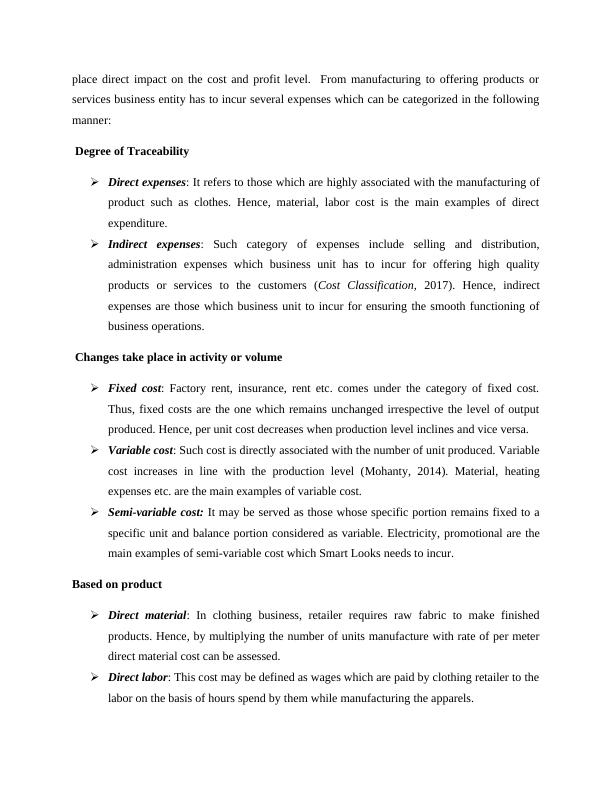
Overhead cost: Cost which is incurred by Smart Looks other than material and labor is
considered as overhead (Mungal and Garbharran, 2014). Hence, selling, administration
etc. are recognized as overhead cost that is vital for the business organization.
Q.2.
(A) Calculation of total cost (TC) and unit cost (UC)
Total costs, as name implies, consists of sum of expenditures that Smart looks has paid to
produce, warehouse or sell the total production output. However, in contrastm, unit cost is the
cost incurred on one unit of production. Here, cost comprises all the payments incurred in
relation with the material, labor and overheds including fixed & variable overheads.
Total costs of production = Total variable cost (TVC) + Total fixed cost (TFC)
Cost/unit = Total cost of production/Number of units produced
Particulars /units Formula 15000 20000 25000
Variable expenses
Purchase of material (£5 per unit*total units ) £75000 £100000 £125000
Wages of labor (£6 per unit*total units) £90000 £120000 £150000
Total variable cost (TVC) Material + labor £165000 £220000 £275000
Total fixed cost (TFC) Given £50000 £50000 £50000
Total cost of production TVC + TFC £215000 £270000 £325000
Units produced or
manufactured 15000U 20000U 25000U
Unit cost
(Total cost of
production/Number of
units produced)
£215,000/1
5,000
= £14.33
£270,000/2
0,000
= £13.50
£325,000
/25,000
= £13.00
considered as overhead (Mungal and Garbharran, 2014). Hence, selling, administration
etc. are recognized as overhead cost that is vital for the business organization.
Q.2.
(A) Calculation of total cost (TC) and unit cost (UC)
Total costs, as name implies, consists of sum of expenditures that Smart looks has paid to
produce, warehouse or sell the total production output. However, in contrastm, unit cost is the
cost incurred on one unit of production. Here, cost comprises all the payments incurred in
relation with the material, labor and overheds including fixed & variable overheads.
Total costs of production = Total variable cost (TVC) + Total fixed cost (TFC)
Cost/unit = Total cost of production/Number of units produced
Particulars /units Formula 15000 20000 25000
Variable expenses
Purchase of material (£5 per unit*total units ) £75000 £100000 £125000
Wages of labor (£6 per unit*total units) £90000 £120000 £150000
Total variable cost (TVC) Material + labor £165000 £220000 £275000
Total fixed cost (TFC) Given £50000 £50000 £50000
Total cost of production TVC + TFC £215000 £270000 £325000
Units produced or
manufactured 15000U 20000U 25000U
Unit cost
(Total cost of
production/Number of
units produced)
£215,000/1
5,000
= £14.33
£270,000/2
0,000
= £13.50
£325,000
/25,000
= £13.00
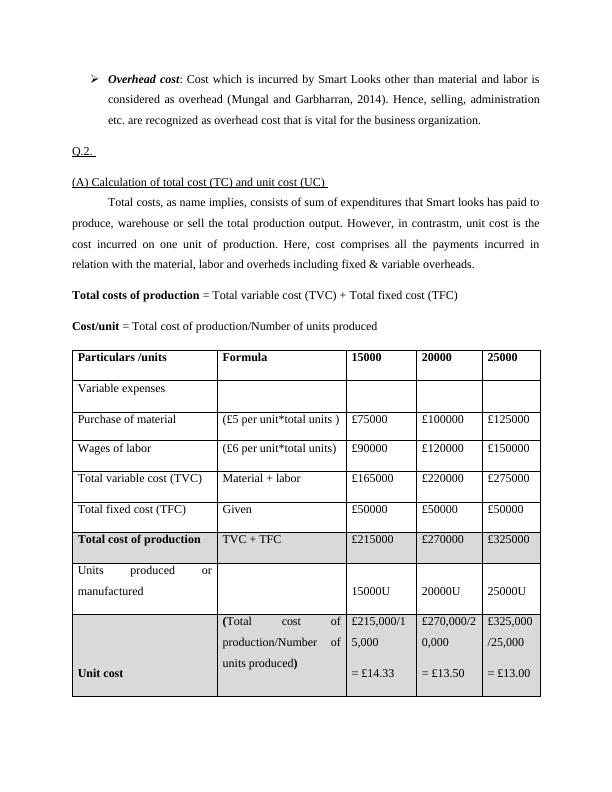
End of preview
Want to access all the pages? Upload your documents or become a member.
Related Documents
Report on Strategic and Competent Policy Frameworklg...
|24
|5145
|60
Management Accounting Assignment tasklg...
|20
|4773
|101
Budget Statements of Smart Looks Limited- Reportlg...
|23
|4865
|64
Managing costs of goods sold under different inventory methodslg...
|19
|5696
|316
MANAGEMENT ACCOUNTING TABLE OF CONTENTSlg...
|27
|4551
|367
MANAGEMENT ACCOUNTING TABLE OF CONTENTS INTRODUCTION 5 Q1.5 a) Classification of cost 5 Q2.7 b) Analysis of inventory 7 Q3. Method 8lg...
|18
|3165
|106
